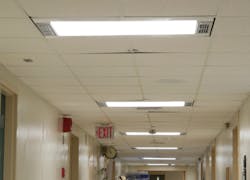The science of aerosols: What you might not know could hurt you
By Dr. Linda D. Lee, MBA
Days passed. It was Christmastime, and Lorie was busy with family and friends. But by New Year’s Day, she was much worse, and headed to the ER for help. After lab work, CT scans, and other tests, she was admitted to the hospital for what would turn out to be a six-week stay to receive very strong intravenous antibiotics. Lorie was diagnosed with a bacterial blood infection that had settled in her heart, causing a life-threatening case of endocarditis.
Aerosols in the treatment room
An aerosol is a tiny bit of liquid or solid (less than 10 microns) suspended in a gas or air. It’s finer than a splash, spray, or spatter, and it hangs in the air longer. Exactly how long aerosol stays in the air depends on the size and weight of the suspended material as well as the room ventilation, but it can range from seconds to hours, certainly long enough to be inhaled or to settle on nearby surfaces. High-speed rotational and ultrasonic instruments contribute to aerosolization. Contamination in a dental office was found to be 16 times higher than in a typical indoor space(1) and spread throughout the entire room.(2)
To cite just two examples of how long airborne pathogens can persist, Pseudomonas aeruginosa was found in the air 45 minutes after aerosolization,(3) and tuberculosis (TB) droplet nuclei were found lingering in the air for several hours.(4) Pathogens that land on surfaces, such as clothing or bibs, can be thrown into the air again by movement of those items.(5)
Dental patients are vulnerable to inhaling bacteria present in the air, or having it enter their system through their oral mucosa.
“It was a very frightening situation once the doctors determined the bacterial infection had settled in my heart,” said Robertson. “One I couldn't have imagined developing as a result of such a routine dental procedure. I was blessed to have an entire team of doctors and specialists who were very concerned about me and who brought me back to good health. I'm grateful for each of them.”
But patients aren’t the only ones at risk.
Keeping safe
In the late 1980s, the Occupational Safety and Health Administration (OSHA) enacted rules to protect health-care workers, including dentists, dental hygienists, and others in the dental field against blood-borne pathogens. There are many requirements to protect employees when they perform dental procedures.(6) Personal protective equipment for infection control and protection from blood-borne pathogens required for OSHA compliance, including mask, gloves, glasses, and face shield, offer some defense against spatter, but is it enough? What about the air that everyone is breathing long after the procedure is completed? Are dental office employees really protected?
They may not be. While the physical barriers will stop splashes, spray, and spatter that occur during dental clinical procedures, smaller particles are suspended in the air. Masks can help, if they are the right type and fitted correctly. The bacterial filtration efficiency (BFE) rating measures the filtration efficiency by percent of a mask using viable (live) bacterial cells that vary in size from one to five microns. The particulate filtration efficiency (PFE) rating measures even smaller particles, from 0.1 to 1.0 micron. Masks should have good ratings for both these features. But to be effective, mask use must be consistent and appropriate. Leakage can occur at the edges of the mask, especially around the bottom, so fit is important too.
Other ways to help lessen the chance that a patient might transmit a disease-causing infection to staff include keeping the patient in a supine position, which lets staff members stay out of the direct breath of the patient. Also, some recommend rinsing the patient’s mouth with an antiseptic before work begins. Suction should be used appropriately. Patients with active TB should not be treated unless absolutely necessary, and attending staff should wear properly fitted respirators and adhere to the American Dental Association (ADA) and Centers for Disease Control and Prevention (CDC) recommendations for preventing transmission.
Air purification
One way to take a further step toward patient and provider safety is air purification. Cleaning the air of bacteria and fungus yields a healthier environment for everyone. But how can you clean something you can’t even see? You can use light to clean the air—specifically, ultraviolet light (UV-C), a shortwave, germicidal UV, which damages the DNA in the contaminants, effectively rendering them inert.(7)
VidaShield offers a UV-C system that operates continuously and unobtrusively to reduce airborne bacteria. VidaShield self-contained ceiling light fixtures are easy to install and require no operator. Small fans pull room air through MERV6 filters into the unit across the face of the shielded UV bulb, where it is purified. The cleaned air is then pushed back into the room to help circulation. Levels of bacteria and fungus are reduced, and indoor air quality is improved as odors are lessened. Patients and staff get the benefit of cleaner air.
In a series of studies in hospitals, the VidaShield system demonstrated these reductions in airborne bacteria:
- Hospital A ICU—79%
- Hospital A OR breakroom—81%
- Hospital B patient room—91%
- Hospital C psych unit—80% (8)
VidaShield installation at a hospital in Massachusetts
Lorie, who has fully recovered, doesn’t blame her dentist for what happened. While there’s no hard evidence her infection occurred during her dental procedure, she hopes no one—patient or staff—would ever have to deal with such a terrible circumstance.
Harmful airborne contaminants and infectious diseases such as mumps, measles, influenza, and tuberculosis are present in the community, and can pose a greater risk in a closed environment. Dental offices should use all possible methods to lower the danger that aerosols present to their patients and their staff.
Dr. Linda D. Lee, MBA, has spent over 30 years in healthcare having previously worked for CH2M Hill, WM Healthcare Solutions, Inc., the University of Texas MD Anderson Cancer Center and Stericycle, Inc. She is a speaker and author of numerous peer reviewed journals/publications and three books published by the American Hospital Association. She has been a recent speaker/presenter at SHEA, AIHce, IPACCanada, and the C Diff Foundation. She graduated with a Bachelors in Environmental Health Science from Indiana State University. She earned a Masters in Operations Management from the University of Arkansas - College of Engineering. She completed a Doctorate of Public Health in Occupational and Environmental Health from the University of Texas Health Science Center. She has an MBA with an emphasis in Healthcare Management. Dr. Lee is a certified indoor air quality manager and currently serves as Chief Science Officer for VidaShield.
References
- Polednik B. Aerosol and bioaerosols particles in a dental office. Environmental Research (2014) 134, 405-9. doi:10.1016/j.envres.2014.06.027
- Rautemaa R, Nordberg A, Wuolijoki-Saaristo K, Meurman JH. Bacterial aerosols in dental practice – a potential hospital infection problem? J Hosp Infec (2006) 64, 76-81. doi:10.1016/jhin.2006.04.011
- Clifton IJ, Fletcher LA, Beggs CB, Denton M, Conway SP, Peckham DG. An aerobiological model of aerosol survival of different strains of Pseudomonas aeruginosa isolated from people with cystic fibrosis. J Cyst Fibros. 2010 Jan; 9 (1):64-8. doi:10.1016/j.jcf.2009.11.004
- https://www.cdc.gov/tb/education/corecurr/pdf/chapter2.pdf Accessed August 16, 2017.
- Shimori T, Miyamoto H, Makishima L, et al. Evaluation of bedmaking-related airborne and surface methicillin-resistant Staphylococcus aureus contamination. 2002. J Hosp Infec 50 (11);30-35. doi:10.1053/jhin.2001.1136
- https://www.osha.gov/SLTC/dentistry/standards.html Accessed August 24, 2017.
- Szymańska J: Dental bioaerosol as an occupational hazard in a dentist’s workplace. Ann Agric Environ Med 2007, 14, 203-207.
- Lee L. Surface and air: what impact does UV-C at the room level have on airborne and surface bacteria? CJIC, 2017, in press.


